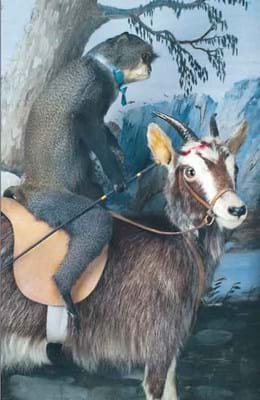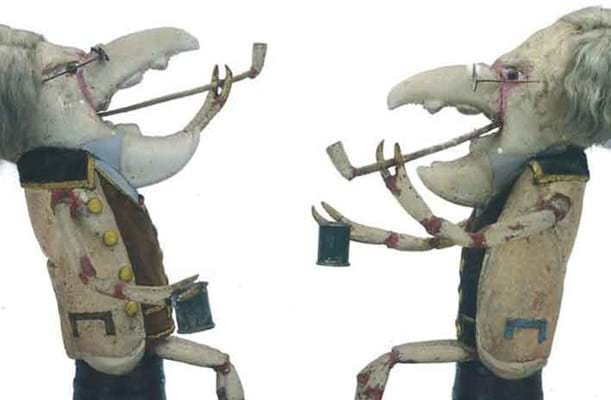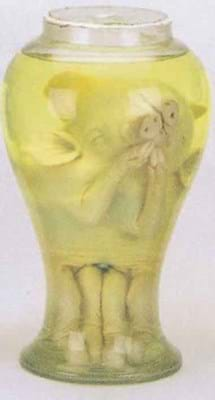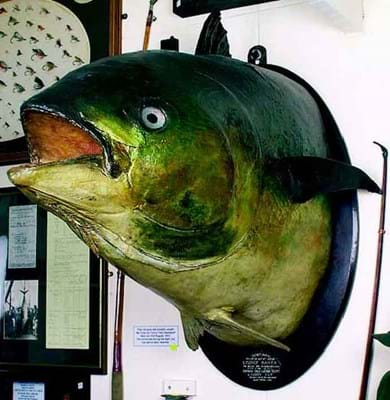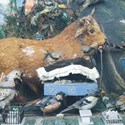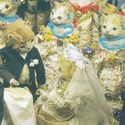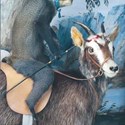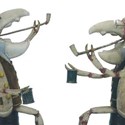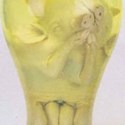Despite the long-running campaign to keep the assemblage intact, and Damien Hirst's claim of an eleventh-hour offer of £1 million plus costs to stop the sale, Bonhams dispersed one of the country's most extraordinary museum collections on September 23-24.
Turn away now if you are squeamish but this really was a sale unlikely ever to be repeated.
Mr Potter's Museum of Curiosities - housed at Jamaica Inn, Bodmin Moor where this auction was held - was established by an extraordinary Victorian.
Like many gentlemen of the period Walter Potter (1835-1918) of Bramber, near Steyning in Sussex, was a selftaught and very able taxidermist but his interest lay not just in the preservation of natural history specimens or game trophies but in mounting animals as if they were miniature humans. His genius was the so-called anthropomorphic tableau - and for more than 140 years the public have paid to see them. It is now plainly clear that some wanted to buy them too.
Although the sale total was well below the £2million figure thrown around when the vendors (recently retired publicans Wendy and John Watts at the inn made famous by Daphne Du Maurier's novel) had tried to sell as a going concern, Bonhams were understandably delighted with the result of two days work that had brought them unprecedented publicity.
From Queen Victoria's bath from the Royal Train (£2100) to a massive leather boot, 3ft 7in (1.09m) long, made by Glover Brothers of Wellingborough for the 1851 Great Exhibition (£5000) this was a copywriter's dream and it will be some time before Bonhams repeat a fourpage spread in Taxidermy Today and a slot on the six o'clock news.
Bidding for a national treasure were an eclectic crowd of more than 400 - "lots of beards" was one barbed assessment - including nostalgia buyers, freak-show enthusiasts plus celebrities such as Pop artist Peter Blake, photographer David Bailey and comedian Harry Hill.
Leamington Spa dealer Robert Chinnery of The Victorian Taxidermy Company was also there to buy Potter's first and best-known creation, The Death and Burial of Cock Robin. Inspired by the hand-coloured illustrations in a book of nursery rhymes, this bizarre display contains 98 individual specimens telling the full nursery rhyme in great detail - the sparrow with the bow and arrow, the rook with his book, the bull who could pull tolling the bell and the owl who dug the grave with his pick and shovel. Seven years in the making,Potter had completed it in 1861 and - always taking pride of place at the front of the museum - its subsequent success as a public attraction helped mark his career path.
Quite what it was worth was another matter altogether. The estimate was £5000-7000 but Mr Chinnery was happy to secure it with a bid of £20,000. "In my opinion, this is the best tableau by Walter Potter…and the most important," he said. "It is the one everyone associates with him and it is in perfect condition."
Mr Chinnery was the underbidder of The Kittens' Wedding, Potter's last large work completed in 1898. It does exactly what it says on the tin - 20 kittens wearing morning suits or dresses of cream brocade complete with parson and altar.
This touching little scene - the only tableau Potter created where the animals are dressed as humans - was a favourite among the 30,000 members of the paying public who visited the Jamaica Inn each year. Such items have traditionally commanded a lot of interest across the Atlantic and the kittens tripled the top estimate when they sold at £18,000 to a phone buyer from America.
Tellingly, The Kittens' Wedding was part of the exhibition Inventing New Britain - The Victorian Vision at the Victoria and Albert Museum three years ago - which gave recognition to the importance of taxidermy in the Victorian interior and highlighted the way 19th century society loved to be shocked, entertained and educated.
It's easy to forget that there were a dozen taxidermists at the Great Exhibition in 1851 when the pastime was in its infancy (Potter himself was likely inspired by German tableaux at Crystal Palace) and that at the turn of the century every town in Britain had a taxidermist and every house at least one case of flora and fauna.
The same US buyer (anything worked pre-1947 is free to export under CITES legislation) also bid £13,000 for a case with 48 small rabbits in a village schoolroom performing various educational tasks.
Staying in the UK, however, was a kittens' tea and croquet party - 37 young felines, 17 seated for dinner, the remainder playing croquet - which sold to a private collector at £16,000.
Selling to the States at £7000 (estimate £600-1000) was Potter's almost surrealist recreation of the Wiston Park Goat, a mischievous beast that no hedge or fence could contain, and the troublesome Shoreham Monkey which perished while raiding a fruit shop.The tale has it that in the animal afterlife the monkey was eternally made to ride the goat to keep him in hand and that's how Potter depicted them against a painted landscape background.
The same rather dark sense of humour was seen in The Squire and the Parson after Dinner - two seated gentlemen smoking clay pipes constructed from lobster parts made by one Mr Williams, 1884 - which sold at £2400. Also turning a few heads (and more stomachs) was a 'freak-show' two-headed lamb mounted for display in a field scene within a glazed display case in the early 20th century, which sold at £2600 against an estimate of £500-700, and a Siamese pig preserved in formaldehyde - of which Hirst would have been proud - which sold (along with a Neolithic stone hammer, a pair of brass swan-head taps and a Greek alabaster vase) at a five-times estimate £2400.
Cased fish, long assimilated into the mainstream of the antiques trade, are somehow the more acceptable face of the hobby.
Here there were many but the most highly-prized example was typically weird - an eellike marine lamprey by Cooper & Sons. It would be hard to find another so, even though it was restored, this one brought £2500 (estimate £500-700). A massive tunny head mounted on an oval oak backboard had a gilt-painted legend reading 763lb tunny killed on September 10th 1933 by George Barker 25 miles off Scarborough after 4 hours 55 mins winning Paul Latham Trophy and Hardy Cup for Best Fish of the Year on a rod and 54 thread line. Tuna off the Yorkshire coast?
Apparently there was a period in the first half of the last century when big game fishermen headed to Scarborough for exactly that. This monster specimen was sold together with the Hardy tackle that caught it (aFortuna Duraluminbig game reel andPalakonaone-piece rod that itself was probably worth £1500). It sold at £4800 to Mr Chinnery.
This trophy was one of a number of items offered primarily on the second day that were relatively recent additions to the collection under the enthusiastic curatorship of Wendy and John Watts.
They brought in the big game - including an early 20th century head of a black rhinocerous which sold at the top end of a £5000-8000 estimate - plus two rather flea-bitten specimens that gained a lot by association.
Although it was in very poor condition, a North American grizzly bear - as featured in the shop of TV's Steptoe and Son- brought a substantial £6500.TV fame was also attached to an early 20th century ferret stuffed and mounted by Gerrard & Sons, London.
The rodent had accompanied the Last of the Summer Wine character Compo seen at the end of each episode hurtling downhill in an enamel bath. At Jamaica Inn it sold at £350.
On a more serious note, there were plenty of more traditional taxidermy specimens with bids to suggest that a subject once considered the preserve of natural history enthusiasts and eccentrics is gaining momentum with the recent input of the interior decorating community and dealers in more 'serious' antiques.
Underlining Mr Chinnery's comment that what a decade ago was £100 may now cost £1000, was a scarlet ibis mounted by Potter with dried grass on an ebonised wood base under a glass dome - a 21in (53cm) high work which sold at a quadrupleestimate £1600 - and a pair of New Zealand kiwis mounted by E. Gerrard & Son which sold at £1050 against expectations of £300-400.



